Evaluation of Post-Fire Treatments (Erosion Barriers) on Vegetation Recovery Using RPAS and Sentinel-2 Time-Series Imagery
Highlights
- RPAS and Sentinel-2 enable multi-scale assessment of erosion barriers (EB).
- NDVI higher upstream of erosion barriers; vegetation height lower in treated sites.
- Remote sensing offers operational tools for post-fire restoration monitoring.
- Long-term monitoring is key to evaluating EB effectiveness and land management.
Abstract
1. Introduction
2. Materials and Methods
2.1. Study Area
2.2. Materials
2.2.1. Satellite Data
2.2.2. RPAS Imagery
2.2.3. Climatic Anomalies
2.3. Sampling Designs
2.3.1. Analysis of the Differences Between Treatments (Multitemporal Sentinel Data)
2.3.2. Analysis of the Differences Between the EB Areas of Influence (RPAS Imagery)
- Digitization of EB segments. The positions of the erosion barriers are digitized using high-resolution RGB imagery and the DTM. Given variability in the length of the wood stacks, each digitized segment measured between 4 and 6 m.
- Digitization of plots within EB influence areas. Influence areas are defined as the zones directly upstream and downstream of each EB segment. Using each segment as a reference, rectangular plots measuring 3 × 6 m were delineated along the direction of maximum slope. This resulted in paired plots per EB segment—one located above (upstream) and one below (downstream) the barrier. Each pair of plots constitutes an EB test area (hereafter, Test Area-EB).
- Digitization of control plots (Test Areas-NI). Control plots were established in nearby areas with similar slope and ecological conditions, but without EBs. For each EB segment, a corresponding control segment was identified in an adjacent, untreated slope section, typically located upslope and within close proximity. The same spatial configuration (3 × 6 m) and orientation (following the maximum gradient) were used to ensure comparability. This pairing strategy aimed to isolate the effect of EB presence as the primary differentiating factor between treatments.
2.4. Statistical Analysis
- –
- Linear Mixed Models (LMM): Models were fitted for each variable using the lmer() function from the lmerTest package. The Treatment factor was included as a fixed effect to assess systematic differences between EB and NI, while the relative position within each test area was included as a random intercept to account for spatial dependence between observation pairs. Degrees of freedom were approximated using the Satterthwaite method.
- –
- Permutation Tests: Non-parametric permutation tests (oneway_test () from the coin package) were applied to assess the significance of differences in Diff between treatments, without assuming normality of the data. A total of 10,000 resamplings were generated to estimate empirical p-values.
3. Results
3.1. Analysis of NDVI Values over Time (2016–2019)
3.2. Differences Between Influence Areas of the EB
4. Discussion
4.1. Monitoring Post-Fire Recovery at EB and NI Sites Using Sentinel-2 Imagery (2016–2019)
4.2. Differences Between EB Zones of Influence
5. Conclusions
Author Contributions
Funding
Data Availability Statement
Acknowledgments
Conflicts of Interest
Appendix A. Spatial Correlogram of NDVI Values Based on Moran’s I
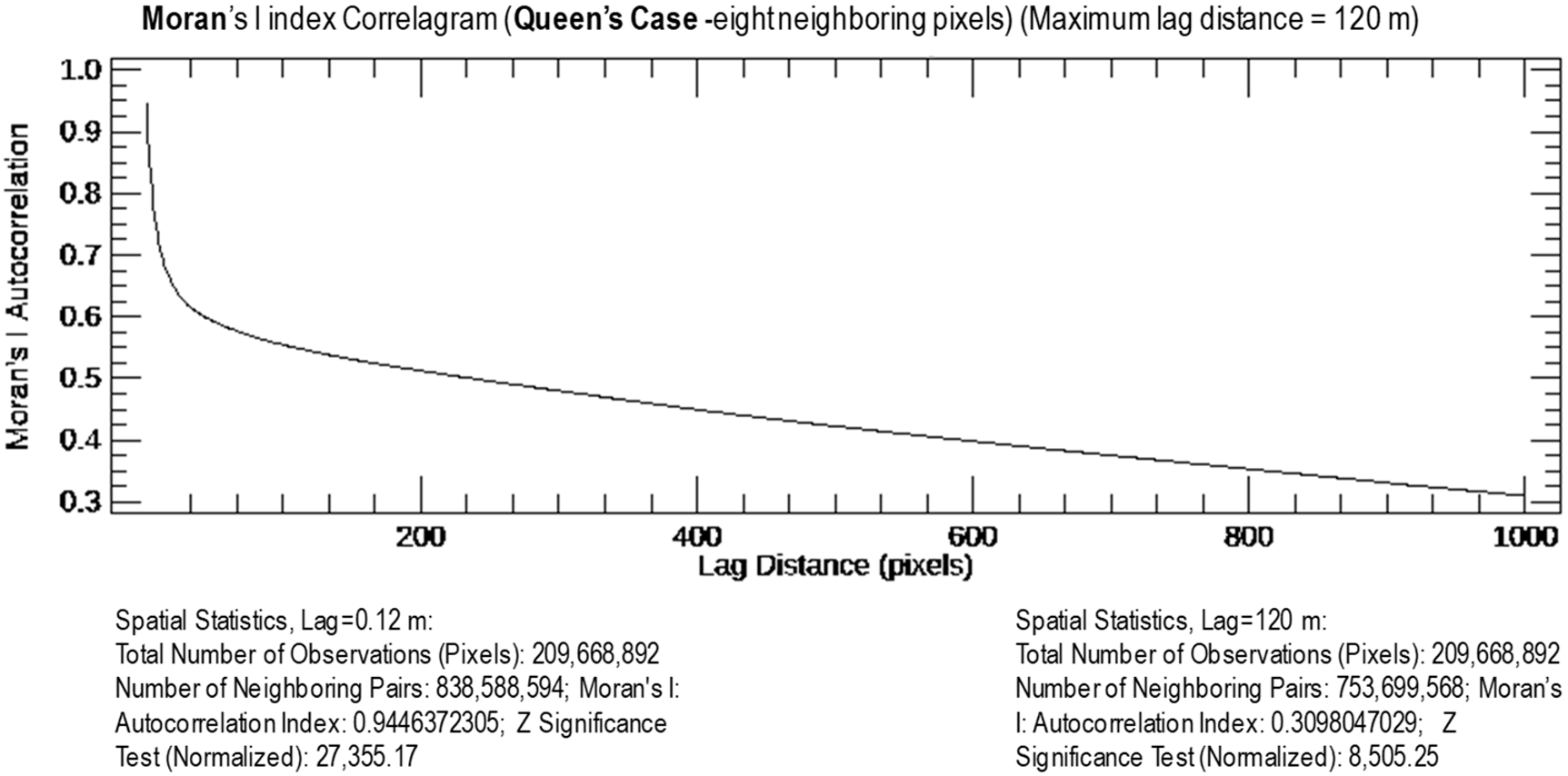
Appendix B. Exploratory Comparative Analysis of NDVI Values Derived from Both Platforms (RPAS & Sentinel-2)
| NDVI | Minimum | Maximum | Mean | Std. Deviation |
|---|---|---|---|---|
| NI_RPAS | 0.1517 | 0.7678 | 0.4291 | 0.0971 |
| EB_RPAS | 0.1289 | 0.7477 | 0.4473 | 0.0836 |
| EB_SENTINEL | 0.2596 | 0.3742 | 0.3161 | 0.0358 |
| NI_SENTINEL | 0.2657 | 0.3907 | 0.3304 | 0.0393 |
| NDVI | NI_RPAS | EB_RPAS | EB_Sentinel | NI_Sentinel |
|---|---|---|---|---|
| NI_RPAS | 1 | 0.0130 | <0.0001 | <0.0001 |
| EB_RPAS | 0.0130 | 1 | <0.0001 | <0.0001 |
| EB_Sentinel | <0.0001 | <0.0001 | 1 | 0.3798 |
| NI_Sentinel | <0.0001 | <0.0001 | 0.3798 | 1 |
Appendix C. Distribution by Treatment (NI & EB) of Vegetation Types Obtained Through Supervised Digital Classification of High-Resolution GeoSAT-2 Imagery
| Bare Ground | Quercus coccifera | Pinus halepensis | Juniperus oxycedrus | Mixture of Brachypodium retusum & Thymus vulgaris | |
| EB | 1.96% | 19.83% | 6.70% | 7.82% | 63.69% |
| NI | 0.00% | 27.07% | 19.23% | 11.60% | 42.02% |
| Imagery provided under the IGN/CNIG–CDTI Collaboration Agreement. Classification used the Maximum Likelihood algorithm with training areas from orthophotos, false-color composites, and field data. Accuracy, validated with GNSS ground-truth data (2023–2024) and orthophotos, exceeded 90% overall (Kappa > 0.85). © GEOSAT. | |||||
Appendix D. Correlation Matrix (Spearman)
| Variables | Mean (ndvi) | Rainfall Anomaly (%) | Thermal Anomaly (°C) |
| Mean (ndvi) | 1 | −0.2554 | −0.0818 |
| Rainfall Anomaly (%) | −0.2554 | 1 | −0.1591 |
| Thermal Anomaly (°C) | −0.0818 | −0.1591 | 1 |
References
- Pausas, J.G.; Llovet, J.; Rodrigo, A.; Vallejo, R. Are wildfires a disaster in the Mediterranean basin? A review. Int. J. Wildland Fire 2008, 17, 713–723. [Google Scholar] [CrossRef]
- MacDonald, L.H.; Huffman, E.L. Post-fire Soil Water Repellency. Soil Sci. Soc. Am. J. 2004, 68, 1729. [Google Scholar] [CrossRef]
- Cerdà, A.; Doerr, S.H. Influence of vegetation recovery on soil hydrology and erodibility following fire: An 11-year investigation. Int. J. Wildland Fire 2005, 14, 423–437. [Google Scholar] [CrossRef]
- Moreno, M.V.; Conedera, M.; Chuvieco, E.; Pezzatti, G.B. Fire regime changes and major driving forces in Spain from 1968 to 2010. Environ. Sci. Policy 2014, 37, 11–22. [Google Scholar] [CrossRef]
- Pausas, J.G.; Keeley, J.E. A burning story: The role of fire in the history of life. Bioscience 2009, 59, 593–601. [Google Scholar] [CrossRef]
- Pausas, J.G. Changes in fire and climate in the eastern Iberian Peninsula (Mediterranean Basin). Clim. Change 2004, 63, 337–350. [Google Scholar] [CrossRef]
- Pereira, P.; Francos, M.; Brevik, E.C.; Ubeda, X.; Bogunovic, I. Post-fire soil management. Curr. Opin. Environ. Sci. Health 2018, 5, 26–32. [Google Scholar] [CrossRef]
- Doerr, S.H.; Cerdà, A. Fire effects on soil system functioning: New insights and future challenges. Int. J. Wildland Fire 2005, 14, 339–342. [Google Scholar] [CrossRef]
- Vallejo, V.R.; Arianoutsou, M.; Moreira, F. Fire ecology and post-fire restoration approaches in southern european forest. In Post-Fire Management and Restoration of Southern European Forests; Moreira, F., Arianoutsou, M., Corona, P., De las Heras, J., Eds.; Springer: Dordrecht, The Netherlands, 2012; pp. 93–119. ISBN 978-94-007-2208-8. [Google Scholar]
- Robichaud, P.R.; Ashmun, L.E.; Sims, B.D. Post-Fire Treatment Effectiveness for Hillslope Stabilization; RMRS-GTR-240 General Technical Report; United States Department of Agriculture: Fort Collins, CO, USA, 2010; pp. 1–62. [CrossRef]
- COST Association. COST Action FP0701—Post-Fire Forest Management in Southern Europe. Available online: https://www.cost.eu/actions/FP0701/ (accessed on 16 November 2023).
- Wohlgemuth, P.M.; Hubbert, K.R.; Robichaud, P.R. The effects of log erosion barriers on post-fire hydrologic response and sediment yield in small forested watersheds, Southern California. Hydrol. Process. 2001, 15, 3053–3066. [Google Scholar] [CrossRef]
- Wittenberg, L.; van der Wal, H.; Keesstra, S.; Tessler, N. Post-fire management treatment effects on soil properties and burned area restoration in a wildland-urban interface, Haifa Fire case study. Sci. Total Environ. 2020, 716, 135190. [Google Scholar] [CrossRef] [PubMed]
- Badía, D.; Sánchez, C.; Aznar, J.M.; Martí, C. Post-fire hillslope log debris dams for runoff and erosion mitigation in the semiarid Ebro Basin. Geoderma 2015, 237, 298–307. [Google Scholar] [CrossRef]
- Klauberg, C.; Hudak, A.T.; Silva, C.A.; Lewis, S.A.; Robichaud, P.R.; Jain, T.B. Characterizing fire effects on conifers at tree level from airborne laser scanning and high-resolution, multispectral satellite data. Ecol. Modell. 2019, 412, 108820. [Google Scholar] [CrossRef]
- Raftoyannis, Y.; Spanos, I. Evaluation of log and branch barriers as post-fire rehabilitation treatments in a Mediterranean pine forest in Greece. Int. J. Wildland Fire 2005, 14, 183. [Google Scholar] [CrossRef]
- Fernández, C.; Fontúrbel, T.; Vega, J.A. Effects of pre-fire site preparation and post-fire erosion barriers on soil erosion after a wildfire in NW Spain. Catena 2019, 172, 691–698. [Google Scholar] [CrossRef]
- Fernández, C.; Vega, J.A.; Jiménez, E.; Fonturbel, T. Effectiveness of three post-fire treatments at reducing soil erosion in Galicia (NW Spain). Int. J. Wildland Fire 2011, 20, 104–114. [Google Scholar] [CrossRef]
- Robichaud, P.R.; Beyers, J.L.; Neary, D.G. Evaluating the Effectiveness of Postfire Rehabilitation Treatments; RMRS-GTR-6 General Technical Report; United States Department of Agriculture: Fort Collins, CO, USA, 2000; p. 85.
- López-Vicente, M.; Kramer, H.; Keesstra, S. Effectiveness of soil erosion barriers to reduce sediment connectivity at small basin scale in a fire-affected forest. J. Environ. Manag. 2021, 278, 111510. [Google Scholar] [CrossRef]
- Albert-Belda, E.; Bermejo-Fernández, A.; Cerdà, A.; Taguas, E.V. The use of Easy-Barriers to control soil and water losses in fire-affected land in Quesada, Andalusia, Spain. Sci. Total Environ. 2019, 690, 480–491. [Google Scholar] [CrossRef] [PubMed]
- Aristeidis, K.; Vasiliki, K. Evaluation of the post-fire erosion and flood control works in the area of Cassandra (Chalkidiki, North Greece). J. For. Res. 2015, 26, 209–217. [Google Scholar] [CrossRef]
- Girona-García, A.; Vieira, D.C.S.; Silva, J.; Fernández, C.; Robichaud, P.R.; Keizer, J.J. Effectiveness of post-fire soil erosion mitigation treatments: A systematic review and meta-analysis. Earth Sci. Rev. 2021, 217, 103611. [Google Scholar] [CrossRef]
- Marcolin, E.; Marzano, R.; Vitali, A.; Garbarino, M.; Lingua, E. Post-Fire Management Impact on Natural Forest Regeneration through Altered Microsite Conditions. Forests 2019, 10, 1014. [Google Scholar] [CrossRef]
- Fernández-Guisuraga, J.M.; Calvo, L.; Fernández-García, V.; Marcos-Porras, E.; Taboada, Á.; Suárez-Seoane, S. Efficiency of remote sensing tools for post-fire management along a climatic gradient. For. Ecol. Manag. 2019, 433, 553–562. [Google Scholar] [CrossRef]
- Pérez-Cabello, F.; Montorio, R.; Alves, D.B. Remote sensing techniques to assess post-fire vegetation recovery. Curr. Opin. Environ. Sci. Health 2021, 21, 100251. [Google Scholar] [CrossRef]
- Frazier, R.J.; Coops, N.C.; Wulder, M.A.; Hermosilla, T.; White, J.C. Analyzing spatial and temporal variability in short-term rates of post-fire vegetation return from Landsat time series. Remote Sens. Environ. 2018, 205, 32–45. [Google Scholar] [CrossRef]
- Kato, A.; Thau, D.; Hudak, A.T.; Meigs, G.W.; Moskal, L.M. Quantifying fire trends in boreal forests with Landsat time series and self-organized criticality. Remote Sens. Environ. 2020, 237, 111525. [Google Scholar] [CrossRef]
- Vo, V.D.; Kinoshita, A.M. Remote sensing of vegetation conditions after post-fire mulch treatments. J. Environ. Manag. 2020, 260, 109993. [Google Scholar] [CrossRef] [PubMed]
- Vlassova, L.; Pérez-Cabello, F. Effects of post-fire wood management strategies on vegetation recovery and land surface temperature (LST) estimated from Landsat images. Int. J. Appl. Earth Obs. Geoinf. 2016, 44, 171–183. [Google Scholar] [CrossRef]
- Vacca, G.; Vecchi, E. UAV Photogrammetric Surveys for Tree Height Estimation. Drones 2024, 8, 106. [Google Scholar] [CrossRef]
- van Iersel, W.; Straatsma, M.; Addink, E.; Middelkoop, H. Monitoring height and greenness of non-woody floodplain vegetation with UAV time series. ISPRS J. Photogramm. Remote Sens. 2018, 141, 112–123. [Google Scholar] [CrossRef]
- Kim, J.; Kim, I.; Ha, E.; Choi, B. UAV Photogrammetry for Soil Surface Deformation Detection in a Timber Harvesting Area, South Korea. Forests 2023, 14, 980. [Google Scholar] [CrossRef]
- Alexiou, S.; Papanikolaou, I.; Schneiderwind, S.; Kehrle, V.; Reicherter, K. Monitoring and Quantifying Soil Erosion and Sedimentation Rates in Centimeter Accuracy Using UAV-Photogrammetry, GNSS, and t-LiDAR in a Post-Fire Setting. Remote Sens. 2024, 16, 802. [Google Scholar] [CrossRef]
- Johansen, K.; Erskine, P.D.; McCabe, M.F. Using Unmanned Aerial Vehicles to assess the rehabilitation performance of open cut coal mines. J. Clean. Prod. 2019, 209, 819–833. [Google Scholar] [CrossRef]
- Tian, J.; Wang, L.; Li, X.; Gong, H.; Shi, C.; Zhong, R.; Liu, X. Comparison of UAV and WorldView-2 imagery for mapping leaf area index of mangrove forest. Int. J. Appl. Earth Obs. Geoinf. 2017, 61, 22–31. [Google Scholar] [CrossRef]
- Zhang, X.; Zhang, F.; Qi, Y.; Deng, L.; Wang, X.; Yang, S. New research methods for vegetation information extraction based on visible light remote sensing images from an unmanned aerial vehicle (UAV). Int. J. Appl. Earth Obs. Geoinf. 2019, 78, 215–226. [Google Scholar] [CrossRef]
- López-Vicente, M.; Cerdà, A.; Kramer, H.; Keesstra, S. Post-fire practices benefits on vegetation recovery and soil conservation in a Mediterranean area. Land Use Policy 2021, 111, 105776. [Google Scholar] [CrossRef]
- Key, C.H.; Benson, N.C. Landscape Assessment (LA) Sampling and Analysis Methods; RMRS-GTR-164-CD General Technical Report; USDA Forest Service: Fort Collins, CO, USA, 2006.
- Montorio, R.; Pérez-Cabello, F.; Borini Alves, D.; García-Martín, A. Unitemporal approach to fire severity mapping using multispectral synthetic databases and Random Forests. Remote Sens. Environ. 2020, 249, 112025. [Google Scholar] [CrossRef]
- DGA (Gobierno de Aragón). Informes Técnicos y Otras Publicaciones Sobre Incendios Forestales. Available online: https://www.aragon.es/-/publicaciones-e-informes-tecnicos-incendios-forestales (accessed on 16 November 2023).
- Yan, J.; Zhang, G.; Ling, H.; Han, F. Comparison of time-integrated NDVI and annual maximum NDVI for assessing grassland dynamics. Ecol. Indic. 2022, 136, 108611. [Google Scholar] [CrossRef]
- Bolton, D.K.; Gray, J.M.; Melaas, E.K.; Moon, M.; Eklundh, L.; Friedl, M.A. Continental-scale land surface phenology from harmonized Landsat 8 and Sentinel-2 imagery. Remote Sens. Environ. 2020, 240, 111685. [Google Scholar] [CrossRef]
- Long, N.; Millescamps, B.; Guillot, B.; Pouget, F.; Bertin, X. Monitoring the Topography of a Dynamic Tidal Inlet Using UAV Imagery. Remote Sens. 2016, 8, 387. [Google Scholar] [CrossRef]
- Tagle, X. Study of Radiometric Variations in Unmanned Aerial Vehicle Remote Sensing Imagery for Vegetation Mapping. Masters’ Thesis, Lund University, Lund, Sweeden, 2017. [Google Scholar]
- Rouse, J.W.; Haas, R.H.; Schell, J.A.; Deering, D.W.; Harlan, J.C. Monitoring the Vernal Advancement of Natural Vegetation; NASA-GCSFC-132982 Final Report; Texas A&M Universitiy, Remote Sensing Center: College Station, TX, USA, 1974; Volume 6. [Google Scholar]
- Weidner, U.; Förstner, W. Towards automatic building extraction from high-resolution digital elevation models. ISPRS J. Photogramm. Remote Sens. 1995, 50, 38–49. [Google Scholar] [CrossRef]
- Villanueva, J.R.E.; Martínez, L.I.; Montiel, J.I.P. DEM generation from fixed-wing UAV imaging and LiDAR-derived ground control points for flood estimations. Sensors 2019, 19, 3205. [Google Scholar] [CrossRef]
- Zhang, H.; Bauters, M.; Boeckx, P.; Van Oost, K. Mapping canopy heights in dense tropical forests using low-cost UAV-derived photogrammetric point clouds and machine learning approaches. Remote Sens. 2021, 13, 3777. [Google Scholar] [CrossRef]
- Cabrera-Ariza, A.M.; Lara-Gómez, M.A.; Santelices-Moya, R.E.; de Larriva, J.E.M.; Mesas-Carrascosa, F.J. Individualization of Pinus radiata Canopy from 3D UAV Dense Point Clouds Using Color Vegetation Indices. Sensors 2022, 22, 1331. [Google Scholar] [CrossRef]
- Dillner, R.P.; Wimmer, M.A.; Porten, M.; Udelhoven, T.; Retzlaff, R. Combining a Standardized Growth Class Assessment, UAV Sensor Data, GIS Processing, and Machine Learning Classification to Derive a Correlation with the Vigour and Canopy Volume of Grapevines. Sensors 2025, 25, 431. [Google Scholar] [CrossRef]
- Chu, T.; Starek, M.J.; Brewer, M.J.; Murray, S.C.; Pruter, L.S. Characterizing canopy height with UAS structure-from-motion photogrammetry—Results analysis of a maize field trial with respect to multiple factors. Remote Sens. Lett. 2018, 9, 753–762. [Google Scholar] [CrossRef]
- Zhou, X.; Xing, M.; He, B.; Wang, J.; Song, Y.; Shang, J.; Liao, C.; Xu, M.; Ni, X. A Ground Point Fitting Method for Winter Wheat Height Estimation Using UAV-Based SfM Point Cloud Data. Drones 2023, 7, 406. [Google Scholar] [CrossRef]
- Tmušić, G.; Manfreda, S.; Aasen, H.; James, M.R.; Gonçalves, G.; Ben-Dor, E.; Brook, A.; Polinova, M.; Arranz, J.J.; Mészáros, J.; et al. Current practices in UAS-based environmental monitoring. Remote Sens. 2020, 12, 1001. [Google Scholar] [CrossRef]
- Kameyama, S.; Sugiura, K. Effects of differences in structure from motion software on image processing of unmanned aerial vehicle photography and estimation of crown area and tree height in forests. Remote Sens. 2021, 13, 626. [Google Scholar] [CrossRef]
- Pérez-Cabello, F.; Ibarra, P.; Echeverría, M.T.; de la Riva, J. Post-fire land degradation of Pinus sylvestris L. woodlands after 14 years. L. Degrad. Dev. 2010, 21, 145–160. [Google Scholar] [CrossRef]
- Mann, H.B. Nonparametric Tests Against Trend. Econometrica 1945, 13, 245–259. [Google Scholar] [CrossRef]
- Kendall, M.G. Rank Correlation Methods, 4th ed.; Charles Griffin: London, UK, 1975. [Google Scholar]
- Salmi, T.; Määttä, A.; Anttila, P.; Ruoho-Airola, T.; Amnell, T. Detecting Trends of Annual Values of Atmospheric Pollutants by the Mann-Kendall Test and Sen’s Slope Estimates: The Excel Template Application MAKESENS; Finnish Meteorological Institute: Helsinki, Finland, 2002; ISBN 9516975631/9789516975637. [Google Scholar]
- Robichaud, P.R.; Wagenbrenner, J.W.; Brown, R.E.; Wohlgemuth, P.M.; Beyers, J.L. Evaluating the effectiveness of contour-felled log erosion barriers as a post-fire runoff and erosion mitigation treatment in the western United States. Int. J. Wildland Fire 2008, 17, 255–273. [Google Scholar] [CrossRef]
- Fernández, C.; Vega, J.A. Effects of mulching and post-fire salvage logging on soil erosion and vegetative regrowth in NW Spain. For. Ecol. Manag. 2016, 375, 46–54. [Google Scholar] [CrossRef]
- Pesaresi, S.; Mancini, A.; Quattrini, G.; Casavecchia, S. Mapping mediterranean forest plant associations and habitats with functional principal component analysis using Landsat 8 NDVI time series. Remote Sens. 2020, 12, 1132. [Google Scholar] [CrossRef]
- Caturla, R.N.; Raventós, J.; Guàrdia, R.; Vallejo, V.R. Early post-fire regeneration dynamics of Brachypodium retusum Pers. (Beauv.) in old fields of the Valencia region (eastern Spain). Acta Oecologica 2000, 21, 1–12. [Google Scholar] [CrossRef]
- Villarreal, M.L.; Norman, L.M.; Buckley, S.; Wallace, C.S.A.; Coe, M.A. Multi-index time series monitoring of drought and fire effects on desert grasslands. Remote Sens. Environ. 2016, 183, 186–197. [Google Scholar] [CrossRef]
- Rey, F.; Isselin-Nondedeu, F.; Bédécarrats, A. Vegetation dynamics on sediment deposits upstream of bioengineering works in mountainous marly gullies in a Mediterranean climate (Southern Alps, France). Plant Soil 2005, 278, 149–158. [Google Scholar] [CrossRef]
- Gómez-Sánchez, E.; Lucas-Borja, M.E.; Plaza-Álvarez, P.A.; González-Romero, J.; Sagra, J.; Moya, D.; De Las Heras, J. Effects of post-fire hillslope stabilisation techniques on chemical, physico-chemical and microbiological soil properties in mediterranean forest ecosystems. J. Environ. Manag. 2019, 246, 229–238. [Google Scholar] [CrossRef]
- van Blerk, J.J.; West, A.G.; Smit, J.; Altwegg, R.; Hoffman, M.T. UAVs improve detection of seasonal growth responses during post-fire shrubland recovery. Landsc. Ecol. 2022, 37, 3179–3199. [Google Scholar] [CrossRef]
- Pádua, L.; Adão, T.; Guimarães, N.; Sousa, A.; Peres, E.; Sousa, J.J. Post-fire forestry recovery monitoring using high-resolution multispectral imagery from unmanned aerial vehicles. Int. Arch. Photogramm. Remote Sens. Spat. Inf. Sci. ISPRS Arch. 2019, 42, 301–305. [Google Scholar] [CrossRef]
- Martinez, J.L.; Lucas-Borja, M.E.; Plaza-Alvarez, P.A.; Denisi, P.; Moreno, M.A.; Hernández, D.; González-Romero, J.; Zema, D.A. Comparison of Satellite and Drone-Based Images at Two Spatial Scales to Evaluate Vegetation Regeneration after Post-Fire Treatments in a Mediterranean Forest. Appl. Sci. 2021, 11, 5423. [Google Scholar] [CrossRef]
- Fernández-Guisuraga, J.M.; Sanz-Ablanedo, E.; Suárez-Seoane, S.; Calvo, L. Using unmanned aerial vehicles in postfire vegetation survey campaigns through large and heterogeneous areas: Opportunities and challenges. Sensors 2018, 18, 586. [Google Scholar] [CrossRef]
- Marañón-Jiménez, S.; Castro, J.; Querejeta, J.I.; Fernández-Ondoño, E.; Allen, C.D. Post-fire wood management alters water stress, growth, and performance of pine regeneration in a Mediterranean ecosystem. For. Ecol. Manag. 2013, 308, 231–239. [Google Scholar] [CrossRef]



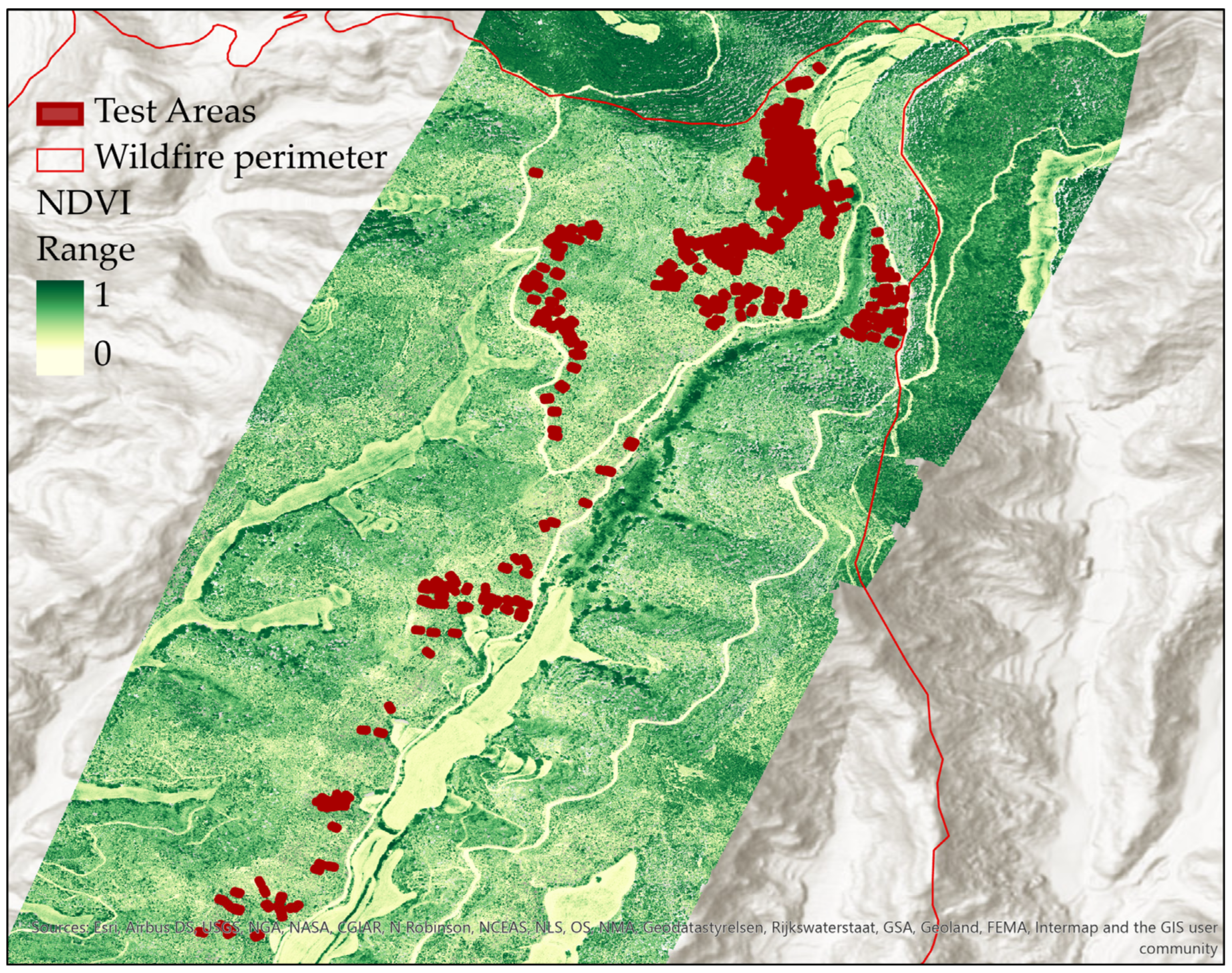
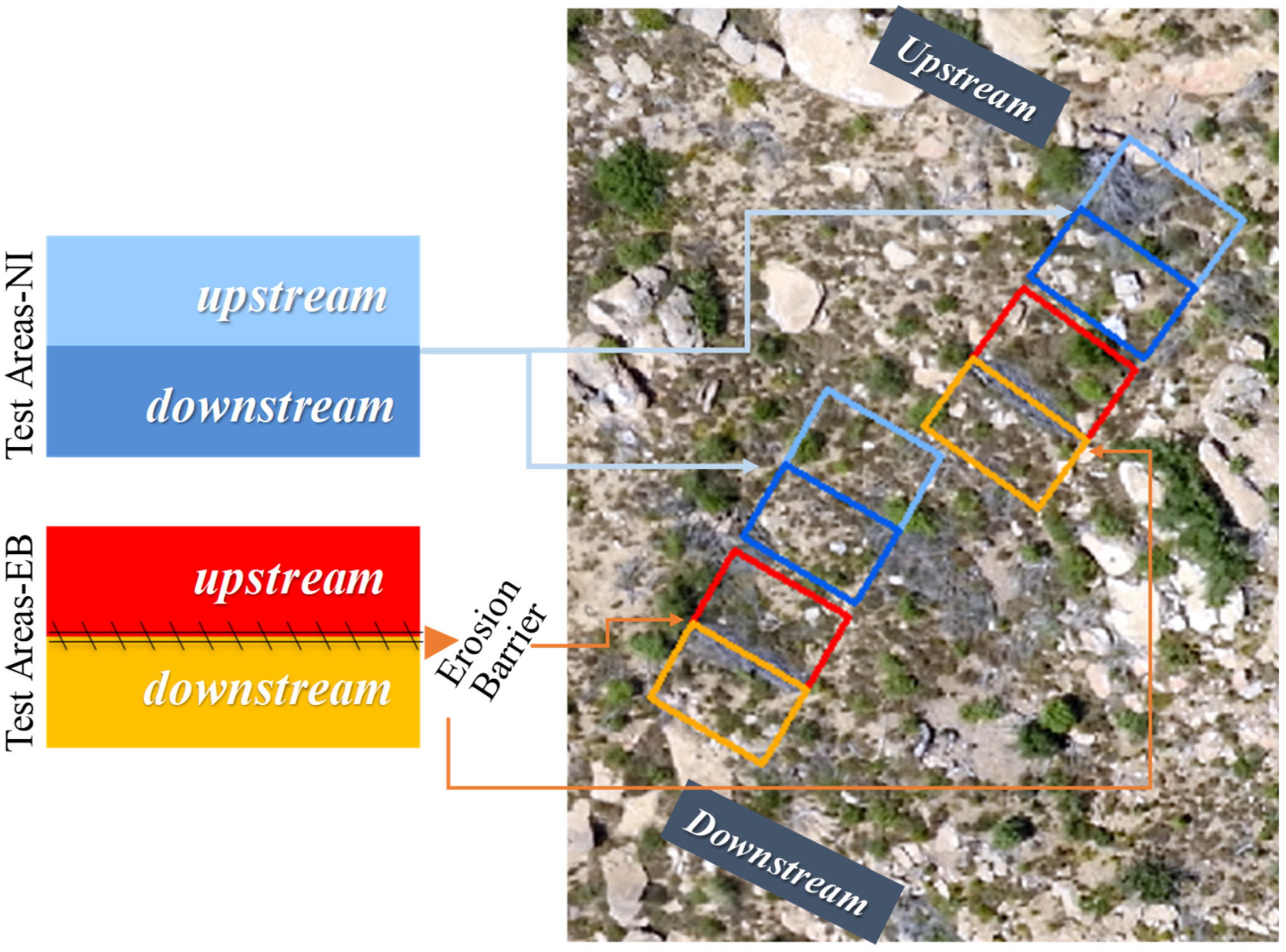
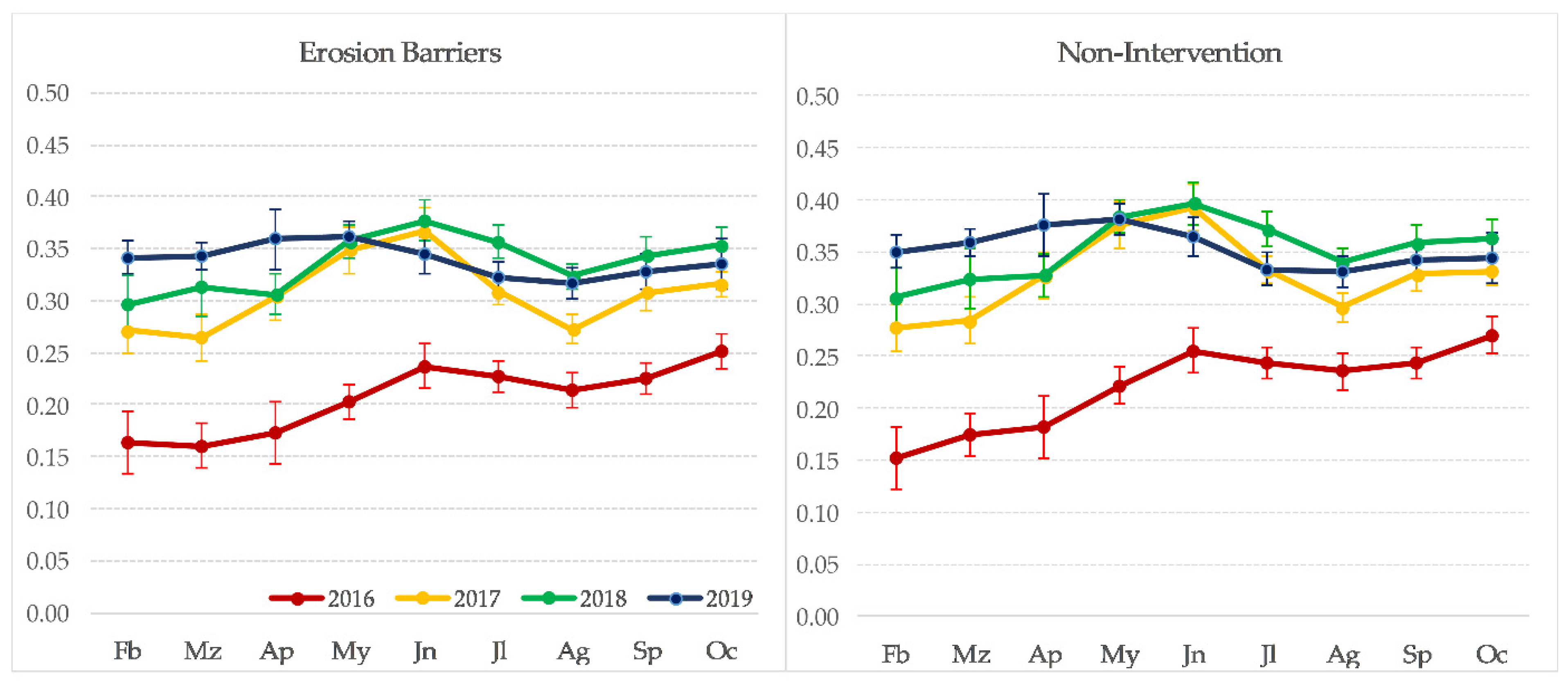
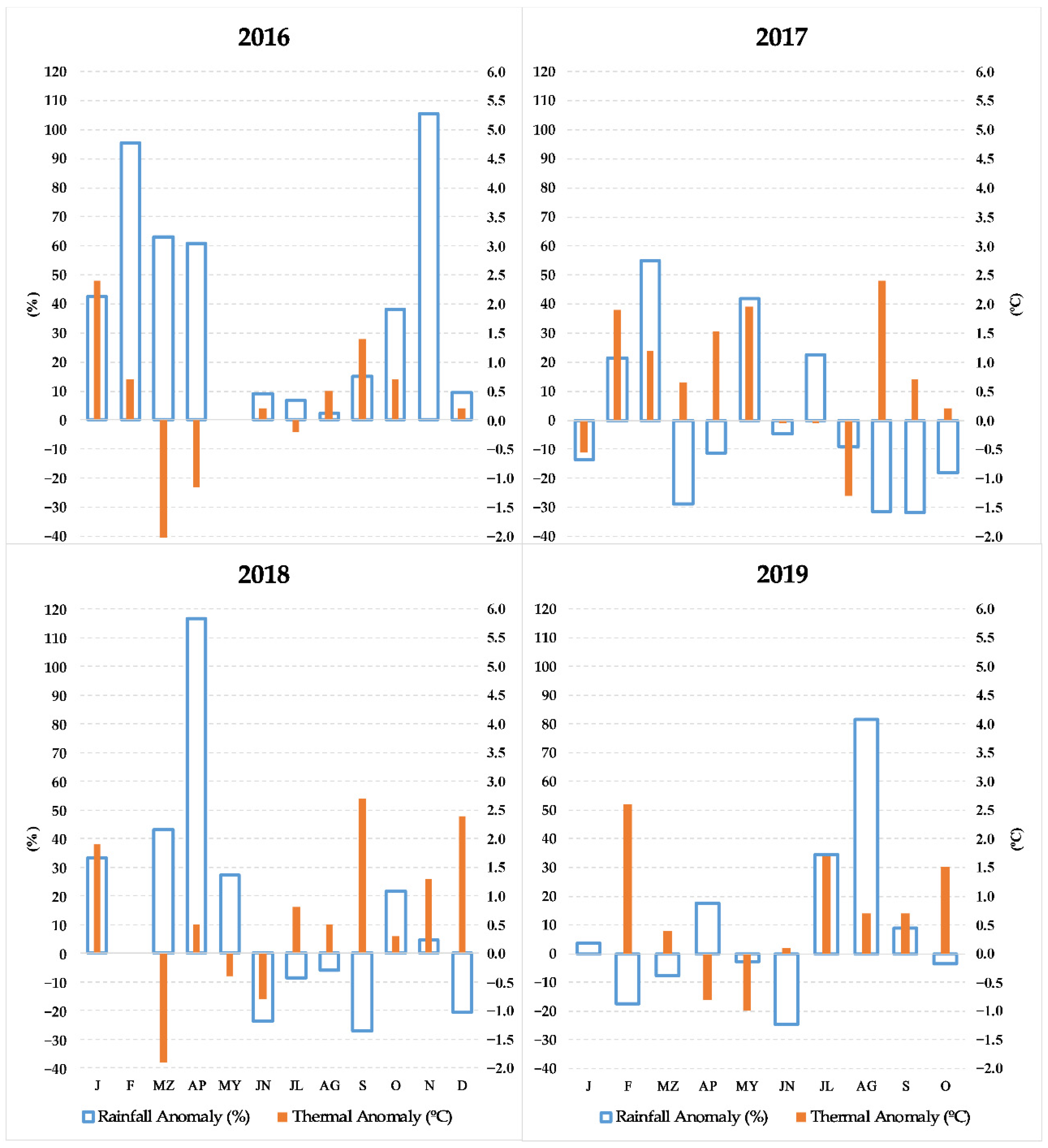
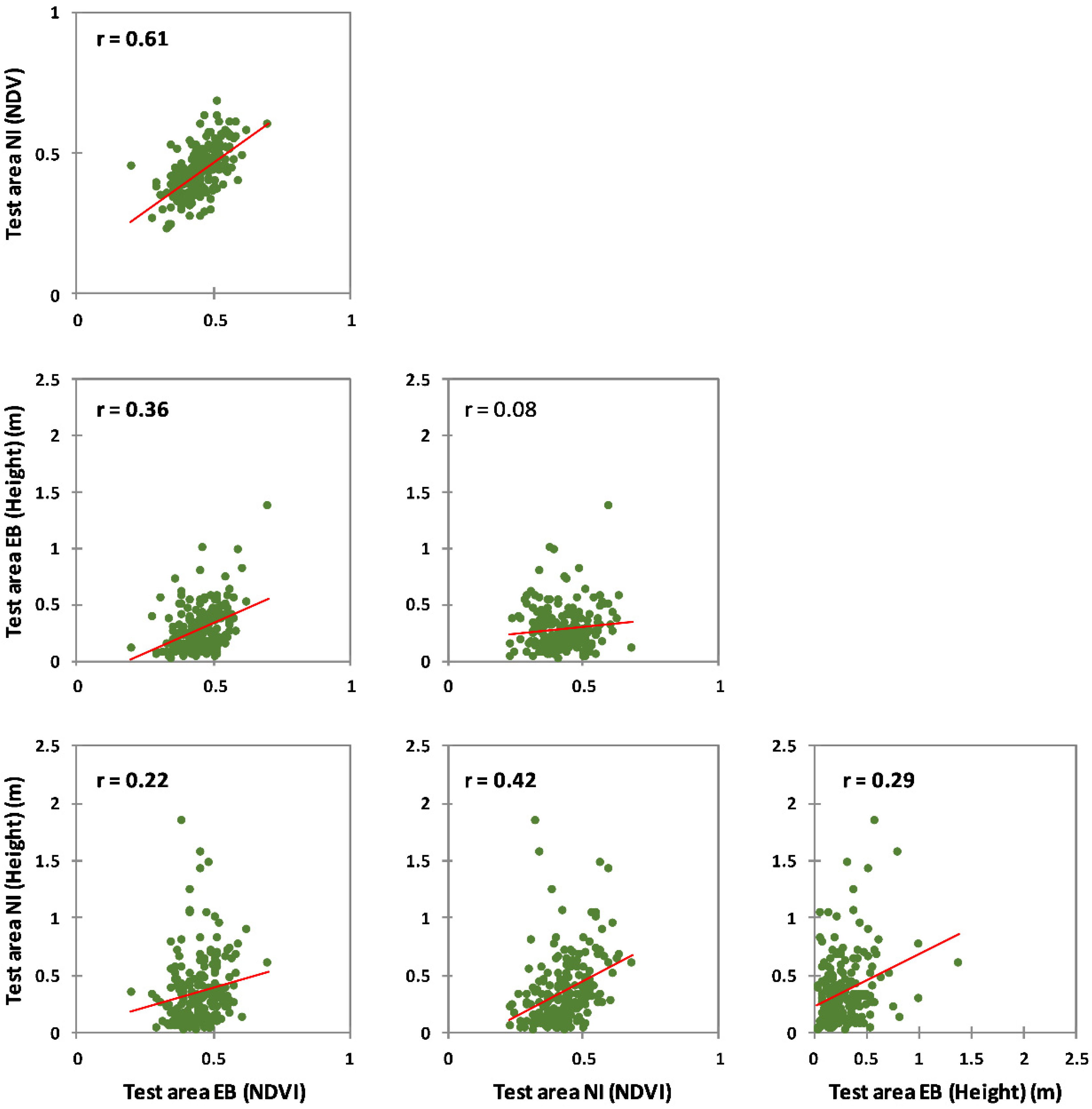
| eBee Plus RTK-PPK | |
|---|---|
| Manufacturer | senseFly Company, Cheseaux-sur-Lausanne, Switzerland |
| Weight | Approx. 1.1 kg |
| Power source | 4900 mAh Lipo |
| Endurance | 59 min |
| GNSS Navigation | RTK-PPK |
| SODA | MicaSense RedEdge-MX | |
|---|---|---|
| Company | senseFly | senseFly |
| Type | BSI CMOS 1-inch | |
| Spectral range | Blue, Green, Red | Blue (475 nm), Green (560 nm), Red (668 nm), Red Edge (717 nm) NIR (840 nm) |
| Image format | JPEG | TIFF |
| Flying height above ground | 100 m | 120 m |
| Ground Sampling Distance | 2.3 cm/pix | 8 cm/pix |
| Company | SenseFly | SenseFly |
| 2016 +0 years | 2017 +1 year | 2018 +2 years | 2019 +3 years | |||||
|---|---|---|---|---|---|---|---|---|
| EB | NI | EB | NI | EB | NI | EB | NI | |
| Min. | 0.088 | 0.073 | 0.233 | 0.225 | 0.245 | 0.236 | 0.233 | 0.263 |
| Max. | 0.313 | 0.322 | 0.468 | 0.479 | 0.461 | 0.459 | 0.462 | 0.453 |
| Mean | 0.215 | 0.231 | 0.305 | 0.326 | 0.340 | 0.357 | 0.338 | 0.352 |
| Stand. Dev. | 0.042 | 0.044 | 0.044 | 0.048 | 0.043 | 0.044 | 0.039 | 0.042 |
| Var. Coef. | 0.195 | 0.188 | 0.145 | 0.146 | 0.125 | 0.123 | 0.115 | 0.118 |
| Month/Year | Difference | Standardized Differences | p-Value |
|---|---|---|---|
| February | 0.007 | 0.597 | 0.551 |
| March | 0.015 | 1.557 | 0.120 |
| April | 0.020 | 1.509 | 0.132 |
| May | 0.023 | 2.492 | 0.013 |
| June | 0.021 | 1.908 | 0.057 |
| July | 0.018 | 2.185 | 0.029 |
| August | 0.018 | 2.359 | 0.018 |
| September | 0.017 | 1.813 | 0.070 |
| October | 0.013 | 1.456 | 0.146 |
| 2016 | 0.017 | 2.621 | 0.009 |
| 2017 | 0.017 | 3.658 | 0.000 |
| 2018 | 0.021 | 4.552 | <0.0001 |
| 2019 | 0.015 | 3.574 | 0.000 |
| NI | EB | |
|---|---|---|
| Kendall’s tau | 0.635 | 0.676 |
| Kendall’s S statistic: nº of concordant pairs minus discordant pairs | 400 | 426 |
| p-value | <0.0001 | <0.0001 |
| Sen’s slope | 0.005 | 0.005 |
| NDVI | NDVI | HEIGHT | HEIGHT | |||||
|---|---|---|---|---|---|---|---|---|
| EB | NI | EB | NI | |||||
| Upstream | Downstream | Upstream | Downstream | Upstream | Downstream | Upstream | Downstream | |
| Mean | 0.455 | 0.439 | 0.426 | 0.432 | 0.272 | 0.285 | 0.376 | 0.341 |
| Minimum | 0.266 | 0.129 | 0.152 | 0.194 | 0.008 | 0.002 | 0.008 | 0.023 |
| Maximum | 0.690 | 0.748 | 0.768 | 0.679 | 1.298 | 1.712 | 2.576 | 1.482 |
| 1st Quartile | 0.399 | 0.377 | 0.362 | 0.364 | 0.108 | 0.122 | 0.127 | 0.121 |
| 3rd Quartile | 0.517 | 0.495 | 0.485 | 0.495 | 0.352 | 0.379 | 0.489 | 0.468 |
| Median | 0.450 | 0.443 | 0.411 | 0.427 | 0.216 | 0.229 | 0.265 | 0.264 |
| Standard deviation (n − 1) | 0.083 | 0.084 | 0.099 | 0.095 | 0.225 | 0.249 | 0.383 | 0.294 |
| Variation coefficient | 0.182 | 0.189 | 0.233 | 0.218 | 0.824 | 0.873 | 1.016 | 0.861 |
| Lower bound on mean (95%) | 0.444 | 0.428 | 0.411 | 0.419 | 0.241 | 0.250 | 0.323 | 0.300 |
| Upper bound on mean (95%) | 0.467 | 0.451 | 0.439 | 0.445 | 0.303 | 0.319 | 0.429 | 0.382 |
| Estimate | Std. Error | t Value | Pr (>|t|) | |
|---|---|---|---|---|
| NDVI | 0.023 | 0.009 | 2.631 | 0.008 ** |
| Height | −0.048 | 0.029 | −1.640 | 0.103 |
Disclaimer/Publisher’s Note: The statements, opinions and data contained in all publications are solely those of the individual author(s) and contributor(s) and not of MDPI and/or the editor(s). MDPI and/or the editor(s) disclaim responsibility for any injury to people or property resulting from any ideas, methods, instructions or products referred to in the content. |
© 2025 by the authors. Licensee MDPI, Basel, Switzerland. This article is an open access article distributed under the terms and conditions of the Creative Commons Attribution (CC BY) license (https://creativecommons.org/licenses/by/4.0/).
Share and Cite
Pérez-Cabello, F.; Baroja-Saenz, C.; Montorio, R.; Angás-Pajas, J. Evaluation of Post-Fire Treatments (Erosion Barriers) on Vegetation Recovery Using RPAS and Sentinel-2 Time-Series Imagery. Remote Sens. 2025, 17, 3422. https://doi.org/10.3390/rs17203422
Pérez-Cabello F, Baroja-Saenz C, Montorio R, Angás-Pajas J. Evaluation of Post-Fire Treatments (Erosion Barriers) on Vegetation Recovery Using RPAS and Sentinel-2 Time-Series Imagery. Remote Sensing. 2025; 17(20):3422. https://doi.org/10.3390/rs17203422
Chicago/Turabian StylePérez-Cabello, Fernando, Carlos Baroja-Saenz, Raquel Montorio, and Jorge Angás-Pajas. 2025. "Evaluation of Post-Fire Treatments (Erosion Barriers) on Vegetation Recovery Using RPAS and Sentinel-2 Time-Series Imagery" Remote Sensing 17, no. 20: 3422. https://doi.org/10.3390/rs17203422
APA StylePérez-Cabello, F., Baroja-Saenz, C., Montorio, R., & Angás-Pajas, J. (2025). Evaluation of Post-Fire Treatments (Erosion Barriers) on Vegetation Recovery Using RPAS and Sentinel-2 Time-Series Imagery. Remote Sensing, 17(20), 3422. https://doi.org/10.3390/rs17203422









